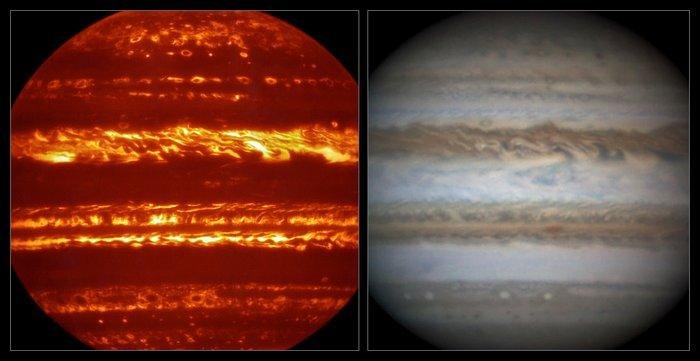1 of 3 | This view compares a "lucky imaging" view of Jupiter from VISIR, on the left, at infrared wavelengths with a very sharp amateur image in visible light from about the same time on the right. Photo by Leigh Fletcher/Damian Peach/European Southern Observatory
LEICESTER, England, June 27 (UPI) -- New images taken from Earth of Jupiter's atmosphere are expected to help make the coming arrival of NASA's Juno mission at the planet more fruitful, astronomers say.
Astronomers at the University of Leicester used the Very Large Telescope at the European Southern Observatory for infrared and visible light views of Jupiter, which are part of a larger campaign to map the planet ahead of Juno's arrival in July.
The Juno spacecraft, launched in 2011, is expected to arrive at Jupiter on July 4, with 37 planned approaches to the planet over the course of a year. Some of the approaches will take it through the planet's clouds in order to study the atmosphere and magnetosphere there.
Astronomers have been gathering data and working on maps of the planet, to prepare for conditions when the probe arrives. In addition to the VLT, they have been using telescopes in Hawaii and Chile, as well as images from amateur astronomers, in order to fully understand recent whether and atmospheric conditions there and how they may affect Juno.
"The combined efforts of an international team of amateur and professional astronomers have provided us with an incredibly rich dataset over the past eight months," Dr. Glenn Orton, a researcher at NASA's Jet Propulsion Laboratory who is leading the support team for Juno, said in a press release.
The new images of Jupiter released by ESO and the University of Leicester were captured using a technique of "lucky imaging" -- taking thousands of short exposure pictures, combining those least affected by Earth's atmosphere into a single image -- with the VLT's Imager and Spectrometer for mid-Infrared, or VISIR.
"At this wavelength, Jupiter's clouds appear in silhouette against the deep internal glows of the planet," Dr. Leigh Fletcher, an astronomer at the University of Leicester, said in a press release. "Images of this quality will provide the global context for Juno's close-up views of the planet at the same wavelength."
The combination of data gathered from Earth and the results of Juno's mission are expected to significantly increase knowledge of the planet.
"Together with the new results from Juno, this dataset will allow researchers to characterise Jupiter's global thermal structure, cloud cover and distribution of gaseous species," Orton said. "We can then hope to answer questions like what drives Jupiter's atmospheric changes, and how the weather we see is connected to processes hidden deep within the planet."















